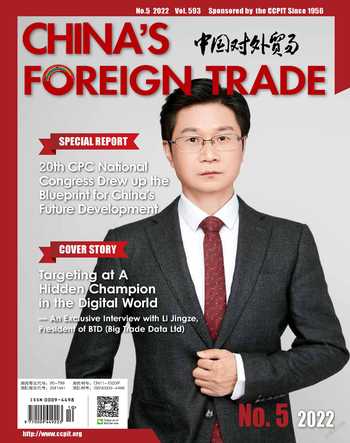RCEP Continues to Expand Its Effects
By Guo Yan

On January 1st this year, the Regional Comprehensive Economic Partnership (or RCEP) agreement was officially enacted, meaning that the worlds largest free trade area is now under construction. “The RCEP is dramatically reducing the tariffs on trade goods in the region, and is positively promoting regional trade, investment and development, as well as improvements in the industrial, supply and value chain through high-level economic and trade rules. The implementation of the RCEP will continue to steadily inject new momentum into the regional and global economy, and will also bring new opportunities for high quality development of Chinese enterprises,” said Zhang Shaogang, Vice Chairman of the China Council for the Promotion of International Trade(CCPIT), during the 2022 China International Fair for Trade in Service and the Second China Foreign Trade Cooperation and Development Forum.
RCEP continues to expand its effects
According to the General Admin- istration of Customs, China managed to maintain steadily increasing foreign trade imports and exports this year, with the total value of imports and exports of goods reaching RMB 23.6 trillion in the seven months from January to July, up 10.4% year-on-year, including exports of RMB 13.37 trillion, up 14.7%, and imports of RMB 10.23 trillion, up 5.3%. The strong performance of China in trade provides an important impetus for the global economic recovery.
“Against the background of the COVID-19 pandemic still raging globally, which challenges the worlds economic recovery, the continuously well-performing foreign trade industry in China is helping to boost global confidence, since it not only contributes to China, but also to the rest of the world,” said Zhang Shaogang. Meanwhile, he also pointed out that the rapid development of science and technology and the changes in the industry format in the post-pandemic era also pose new challenges for Chinas foreign trade.
With regards to this, Zhang Shaogang put forward three suggestions. First, China should effectively intensify its support for foreign trade, and should pay close attention to the implementation of favorable policies to help enterprises of all sizes address difficulties, and strengthen the weak links in foreign trade. Second, China should make efforts to promote the development of digital and cultural trade and other trade in services, by giving full play to the official and civil role of the CCPIT, supporting leading enterprises in trade in services with strong innovation capacity and international competitiveness to allow them to further grow, and encouraging small and medium-sized enterprises to move toward being specialized, differential, refined, and innovative. Third, China should improve the services of digital trade enterprises, such as big data, artificial intelligence and blockchains, with supportive policies, in order to accelerate the development of new business models and formats in foreign trade, while taking a multi-pronged approach to promoting the healthy development of cross-border e-commerce, and the construction of comprehensive pilot zones and overseas warehouses for cross-border e-commerce.
Sri Lankan Ambassador to China Dr. Palitha Kohona said in his speech that this year has been a tough year. He continued by saying that as the pandemic is still rampant, countries and regions face slow economic development, the supply chain has not yet fully recovered, and the tourism is bottoming up. He highly appreciates Chinas success in eradicating extreme poverty and considered it a unique achievement in human history, and he also hoped to further strengthen cooperation between the two countries.
“We are open to foreign investment and Sri Lanka is ideally located in the middle of the Indian Ocean with access to some of the markets with the most potential for industrial products and services in the world. Adjacent to Colombo is the newly developed Colombo Port, which is easily and directly accessible from Africa, the Middle East, India and ASEAN countries, making Sri Lanka attractive to investors in the fields of finance, health and education,” Palitha noted.
According to Joseph Keating, Commercial Counsellor of the Irish Embassy in China, the RCEP, which officially came into effect early this year, also attracted the attention of the EU. He said:“The EU is currently still working on this agreement, which includes 20 chapters and 510 treaties and the annexes. What is clear is that one of the benefits of the agreement, the synergy of rules of origin, will also benefit European companies in the region. With such a rule of origin, companies will no longer face the problem of different rules of origin when manufacturing or transporting products across borders, thus making it easier and more convenient to undertake corporate operations, and reducing the costs of the supply chain across the region.”
Meanwhile, as for some speculation that “lower trade costs among RCEP members may lead to trade diversion, weakening the competitiveness of European products in Asia”, Joseph Keating said: “We firmly believe that free and fair trade and multilateralism are the way to achieve our goals, but we will also be happy when other countries find their own paths and become prosperous and strong. By boosting the global economy, the RCEP will help provide more, not less, opportunities for trade between us and the free trade zone, just as the single market of the EU provides more opportunities for RCEP members.”He also mentioned that at least 65% of the services sector will be fully open to foreigners under the RCEP agreement, which is good news for Ireland, since the value of trade in services between Ireland and China grew nearly six-fold from 2.1 billion to nearly 12 billion in the decade leading up to 2020. Furthermore, trade in goods between China and Ireland will continue to grow despite the impact of the pandemic.
Enhancing competitiveness to effectively seize the business opportunities provided by RCEP
In the post-pandemic era, together with profound changes, the likes of which have not been seen in a century, foreign trade enterprises are facing risks and challenges of unprecedented levels of complexity and severity. Yang Jing, Director of the Agricultural Trade Promotion Center of the Ministry of Agriculture and Rural Affairs, said: “China is exporting agricultural products on a large scale, but the overall competitiveness is not strong in the international market, with exports mainly being of labor-intensive products. In fact, the agricultural export market of China is currently experiencing a hard time as it transforms.”
Due to the COVID-19 pandemic, the global supply and industrial chain has been greatly impacted. However, Chen Jing, President of the China Association of Small and Medium Enterprises, said that Chinas small and medium-sized enterprises were growing against the trend, and the reason behind the growth highlights the well-developed industrial and supply chain in China, as well as the corresponding ability of same to resist risks. She also pointed out that SMEs are facing many opportunities and challenges at the same time now. For example, enterprises are lacking information, since they do not pay enough attention to the introduction of foreign capital and technology; foreign trade enterprises are all alike, meaning they have not fully refined and tapped into their core competitiveness; there is a shortage of professionals and high labor costs; restrained by domestic policies and the increasingly hostile international environment, together with the appreciation of the RMB, rising export costs places heavier burdens on SMEs; and trade protectionism is on the rise in the international market.
In this regard, Chen Jing suggested that enterprises should work on learning and understanding the latest information on the global economy and international trade. It is only through extensive market research, a deep understanding of the economic development and market trends, and comparative analysis of market demand and enterprise products that Chinese enterprises can explore the international market more accurately. Enterprises should strengthen their R&D to continuously develop new products, actively introduce international talent, and take multiple measures to attract overseas science and technology industries to China, and to then help with the development of and innovation in science and technology. Besides this, enterprises should improve their awareness of intellectual property protection, operational capabilities, and technology screening and bargaining abilities, while actively participating in international cooperation through the development of standards for independently innovative products to gain affirmation in overseas markets, and protect the innovation achievements of enterprises.
Li Wei, Vice President of PR Newswire, said that PR Newswire has been in China for 20 years and has served a large number of Chinese enterprises when going abroad, becoming their partners in brand communication in the international market. “From these new brands in various industries to the continuously progression and rapid development of small and medium-sized enterprises, we deeply feel for and are moved by their explorations of going abroad, as well as the resilience.”
Li Wei frankly admitted that its relatively easy for Chinese enterprises to go abroad, but its hard for them to become localized, meaning really integrating into the locale, as brand building is indispensable for this. In this regard, she suggested that the RCEP features a selection of different languages and is culturally diverse, so it firstly needs to build corresponding official regional websites. Secondly, enterprises should take the initiative to do a good job in terms of continuous content output, so as to achieve dynamic, real-time, and efficient communication. Thirdly, enterprises should pay attention to communication paths, especially those which have just emerged, and arent yet known locally, with communication channels covering the most possible media being better choices. In addition, enterprises should establish their own media relationship management framework locally.
Chen Gang, Executive Vice President of Newegg China, believes that the best destinations for going-out Chinese enterprises are these countries and regions where there are already excellent partnerships in place, so as to make it easier to adapt local policies and carry out marketing and operations more smoothly. Meanwhile, enterprises should boost the construction of overseas warehouses, as well as technical empowerment.
According to Yang Jing, enterprises should make full use of the RCEP, and should study the RCEP rules in depth, in order to understand local markets, tariff concessions for agricultural products, customs procedures, inspection and quarantine, and the popularity of their products in the target countries. Then, based on these conditions, they can position their products in such a way as to adapt to the relevant regulations, processes, requirements, and so on for better development of the target markets. Besides this, enterprises should improve the quality of products, use the benchmark of international standards, and fundamentally strengthen the international competitiveness, so as to effectively seize the opportunities presented by the RCEP.
Top 20 cities contributed 65% of the total foreign trade volume in China
At the Forum, the 2022 Report for High Quality Development of China Foreign Trade was released. Fan Peikang, Editor-in-chief of China Trade News, interpreted the report on-site. He explained that, since the 18th CPC National Congress, China has accelerated the construction of the new open economic system and made historic achievements in the development of the foreign trade industry, boosting the transformation from high-speed growth to high-quality development. High-quality development is not only an inevitable choice made by China as the reform and opening-up and the economic development in China enter a new era, but is also an effective response to the profound changes facing the world today.
In 2021, the trade value in goods of Chinas imports and exports totaled RMB 39.1 trillion, topping USD 6 trillion for the first time, and helping China maintain its position as the worlds top trader in goods. The rapid recovery of Chinas foreign trade market and its increasing share in the global market depended on the contribution of each province, autonomous region and municipality. According to the latest provincial foreign trade statistics, in terms of the total annual import and export volume in 2021, seven provincial-level administrative regions performed better than others, including Guangdong Province, Jiangsu Province, Zhejiang Province, Shanghai, Beijing, Shandong Province and Fujian Province, which all contributed to a foreign trade volume of RMB 29.5 trillion, accounting for 75% of the total.
Guangdong, Jiangsu and Zhejiang were the top three, and had a much higher trade surplus. Specifically, Zhejiang and Guangdong recorded a trade surplus of more than RMB 1.8 trillion in 2021. The central and western regions in China are expanding exports. In 2021, seven provincial-level administrative regions had an export growth rate of higher than 30%, namely the Ningxia Hui Autonomous Region, the Tibet Autonomous Region, Shanxi Province, Qinghai Province, the Inner Mongolia Autonomous Region, Shandong Province, Shaanxi Province and Beijing, reflecting the good results seen in the central and western regions. The three provinces of Liaoning, Jilin and Heilongjiang in northeast China also exceeded the national average, demonstrating the results of the projects of the Large-scale Development of the Western Region and the Revitalization of the Northeast. On the whole, provincial-level administrative regions in China still follow the pattern of“one leader and two strong players”, while the central and western regions are on the rise, which may continue for years as a major trend.
According to the latest trade data of cities, there are 20 cities in China with greater advantages in developing the foreign trade industry: Shanghai, Shenzhen, Beijing, Suzhou, Dongguan, Ningbo, Guangzhou, Xiamen, Tianjin, Qingdao, Chengdu, Chongqing, Hangzhou, Wuxi, Nanjing, Foshan, Zhengzhou, Jinhua, Xian and Dalian. The foreign trade volume of the 20 cities listed above totaled RMB 25.8 trillion in 2021, accounting for 65% of Chinas total import and export volume. Of these cities, Qingdao stood out with a growth rate of over 30%.Established foreign trade players were being freed from the impact of the pandemic. For example, in 2019, Suzhou suffered decreases in both foreign trade value and export volume due to factors including rising trade frictions between China and the U.S. and the pandemic. However, the total import and export value of Suzhou started to grow again in 2020, and even hiked in 2021. Suzhou contributed 6.5% and 48.6% to the national and provincial total foreign trade volumes respectively in 2021, and led in terms of per capita import and export value in China.
When analyzing the top 20 foreign trade cities, the main reasons for the achievements can be seen: channel empowerment, which aids the rise of cities in the central and western regions; updated foreign trade models, which inject new momentum into the industry; industrial upgrading; the integration of the digital and real economies, as digital trade is leading the development of the digital economy; and supporting policies.
Furthermore, another report was released at the Forum, the Ecological Development of Digital Trade in the RCEP Region from the Perspective of Corporate Sense of Gain. In the six months since the implementation of the RCEP, the agreement has been enacted in 13 out of 15 member countries, which will create more development space for enterprises as it is a high-level free trade agreement. For example, Chinese enterprises are benefiting from the implementation of the RCEP with tariff preferences, and streamlined customs clearance, etc. Digital trade has also become a new business model for the foreign trade industry, and it is the right time to improve the digital trade ecology in the RCEP region.
A special study group from the China Trade Think Tank conducted research on 57 representative foreign trade enterprises, and asked the respondents to score various aspects of the RCEP digital ecosystem in terms of their sense of gain, operational flexibility and problems, during their RCEP experiences over the last six months. A 5-point scale was used for scoring.
The surveyed companies believed that digital trade has a bright future in the RCEP region, the global division of labor is being reshaped, and the pattern which is predominantly used by the European and American markets is changing. There are incremental markets emerging on the demand side, while the RCEP promotes the gathering of manufacturing industries in Asia. In the RCEP region, there is the largest amount of accumulated data and the most application scenarios, so that enterprises have an average score as high as 4.16 for the prospect of digital trade cross-border e-commerce in the RCEP region, with 84.2% of the respondents scoring higher than 4. Most respondents also have operations in ASEAN countries, reaching 64.9%, while 43.8% are involved with Japan and South Korea, and 19.3% in Australia and New Zealand. It is expected that enterprises will mainly target the markets in Japan, South Korea, Australia and New Zealand, while up to 78.95% of respondents will choose to further develop their links with the ASEAN market.
Link
The Second China Foreign Trade Cooperation and Development Forum, with the theme of “Sharing RCEP Opportunities and Boosting Foreign Trade”, was hosted by the China Council for the Promotion of International Trade (CCPIT), organized by China Trade News and the CCPIT Commercial Industry Committee, and supported by Chinas Foreign Trade, Zhongmao International Culture & Media Co., Ltd. and the CCPIT CSC Exhibition Department. According to Xu Suting, President of China Trade News, in order to better serve foreign trade enterprises and solve the problems of foreign trade enterprises going abroad, China Trade News has been helping to expand the scope, optimize the structure, and improve the quality of openness, while perfecting internal and exter- nal coordination, to provide better services for enterprises participating in international economic cooperation and developing new competitive advantages. This has been carried out by hosting forums to strengthen the international soft power of Chinese enterprises, establishing the China Trade Think Tank, the think tank for soft power of Chinese enterprises, and promoting the plans to improve the international soft power of Chinese enterprises. China Trade News also hopes to intensify the relationships between domestic and foreign enterprises, to provide not only publicity services, but also high-quality wisdom for future development, acting as a paving stone, a guiding light and a safe harbor, and building a bridge between foreign trade enterprises and the relevant state departments.
- China’s foreign Trade的其它文章
- The Development of Foreign Trade in China over Last Decade:Higher-level Opening-up to the Outside World
- New Changes in Travel:Past Visitors Are Become Today’s Experiencers
- China’s Livestreaming Enters A New Phase of Development
- The Pension Industry Calls for New Models and Ecology
- Digital Technology Promotes China-foreign Trade in Agricultural Services
- As Shipping Costs“Dive”,It Is Imperative to Improve the Layout of Industrial Chain

